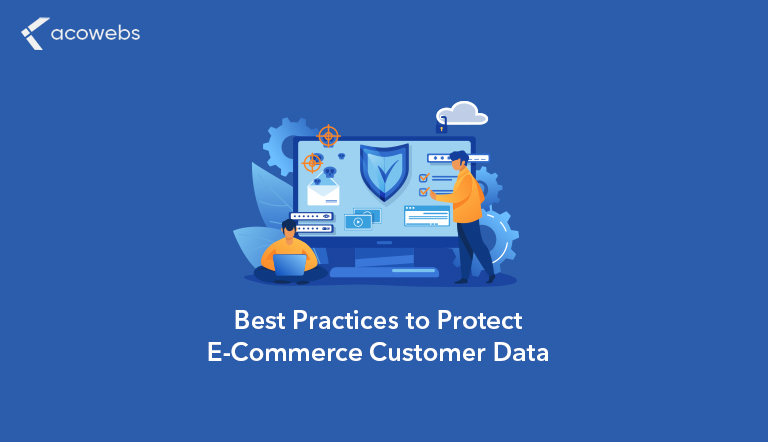Safeguard your e-commerce website and protect sensitive customer data with Techtenstein’s comprehensive guide to best practices in cybersecurity and data protection.
Begin by highlighting the significance of security in e-commerce websites, emphasizing the critical importance of safeguarding sensitive customer data and maintaining trust.

1. Understanding E-commerce Security Risks
- Common Threats
- Discuss prevalent security risks faced by e-commerce websites, including data breaches, payment fraud, phishing attacks, and malware injections.
- Impact of Security Breaches
- Highlight the detrimental consequences of security breaches for e-commerce businesses, such as financial losses, reputational damage, legal liabilities, and loss of customer trust.
2. Importance of Data Security in E-commerce
- Customer Trust and Confidence
- Explain how robust data security measures foster trust and confidence among customers, leading to increased sales, customer loyalty, and positive brand perception.
- Legal Compliance
- Discuss the regulatory requirements and standards governing data protection in e-commerce, including GDPR, PCI DSS, and CCPA, and the implications of non-compliance.
3. Best Practices for Securing E-commerce Websites
- Implementing HTTPS Encryption
- Explain the importance of HTTPS encryption for securing data transmission between the user’s browser and the e-commerce website, protecting sensitive information from interception.
- Strong Authentication Mechanisms
- Discuss the use of multi-factor authentication (MFA) and strong password policies to enhance user authentication and prevent unauthorized access to customer accounts.
4. Secure Payment Processing
- PCI DSS Compliance
- Provide an overview of the Payment Card Industry Data Security Standard (PCI DSS) requirements and the importance of compliance for e-commerce merchants processing card payments.
- Tokenization and Encryption
- Explain how tokenization and encryption techniques help secure payment card data during transactions, reducing the risk of cardholder data theft.
5. Protection Against Malicious Attacks
- Web Application Firewall (WAF)
- Discuss the role of WAFs in protecting e-commerce websites from common web application attacks, such as SQL injection, cross-site scripting (XSS), and brute force attacks.
- Regular Security Audits and Vulnerability Scans
- Highlight the importance of conducting regular security audits and vulnerability scans to identify and remediate potential security weaknesses proactively.
6. Data Privacy and Compliance
- Privacy Policy and Consent Management
- Emphasize the need for transparent privacy policies and robust consent management mechanisms to ensure compliance with data protection regulations and respect user privacy preferences.
- Data Retention and Deletion Policies
- Discuss the importance of establishing clear data retention and deletion policies to minimize the storage of unnecessary customer data and mitigate the risk of data breaches.
7. Employee Training and Awareness
- Security Awareness Training
- Advocate for ongoing security awareness training programs to educate employees about e-commerce security best practices, phishing awareness, and incident response protocols.
- Incident Response Plan
- Stress the importance of developing and regularly testing an incident response plan to effectively respond to security incidents and minimize their impact on the e-commerce business.
8.Data Backup and Disaster Recovery
- Regular Data Backups
- Stress the importance of regularly backing up e-commerce data to mitigate the impact of data loss due to cyber attacks, hardware failures, or natural disasters.
- Disaster Recovery Planning
- Discuss the development of comprehensive disaster recovery plans to ensure timely restoration of e-commerce operations in the event of a security incident or system failure.
9.Securing Data Transmission
- SSL/TLS Encryption
- Highlight the significance of SSL/TLS encryption for securing data transmission between web servers and clients, ensuring confidentiality and integrity of information.
- Content Security Policy (CSP)
- Introduce CSP as a security mechanism for preventing cross-site scripting (XSS) attacks and unauthorized data access by specifying approved sources of content.
10.Monitoring and Incident Response
- Real-time Monitoring
- Highlight the importance of real-time monitoring for suspicious activities and anomalous behavior on e-commerce platforms, enabling prompt detection and response to security incidents.
- Incident Response Plan
- Recommend developing and implementing an incident response plan outlining procedures for responding to security breaches, including containment, investigation, and communication with stakeholders.
11.Regular Security Audits and Vulnerability Assessments
- Scheduled Security Audits
- Stress the importance of conducting regular security audits and vulnerability assessments to identify and remediate potential security weaknesses and vulnerabilities.
- Penetration Testing
- Discuss the role of penetration testing in assessing the effectiveness of security controls and identifying exploitable vulnerabilities before attackers do.
12.Secure Authentication and Access Control
- Strong Password Policies
- Recommend enforcing strong password policies for user accounts, including password complexity requirements, multi-factor authentication (MFA), and regular password updates.
- Role-based Access Control
- Explain the benefits of implementing role-based access control (RBAC) to limit access to sensitive data and functionalities based on users’ roles and permissions.
13.Best Practices for Data Security
- Implementing Encryption
- Explain the importance of encrypting sensitive data, such as payment details and personal information, during transmission and storage using robust encryption protocols.
- Securing Payment Gateways
- Discuss best practices for securing payment gateways, including compliance with PCI DSS standards, implementing tokenization, and regular security audits.
In conclusion, securing e-commerce websites requires a multi-layered approach encompassing technical controls, policies, and employee awareness. Summarize the key points discussed in the article and reinforce the importance of implementing best practices for handling sensitive customer data to protect e-commerce businesses from cyber threats and build trust with customers.



